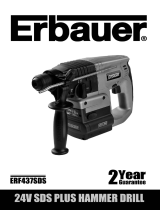
EN
4
Additional security warnings
Additional safety rules for hammer
• Wear ear protectors. Exposure to noise can cause hearing loss.
• Use auxiliary handles, if supplied with the tool. Loss of control can cause personal
injury.
• Hold power tool by insulated gripping surfaces when performing an operation
where the cutting accessory may contact hidden wiring or its own cord.
• The accessory coming into contact with a live wire could cause an electric shock
to the operator.
• Always direct the charger cable away from the machine.
• When working with the machine, always hold it firmly with both hands and stand
firm.
• Always wear a dust protection mask.
• During work breaks or when not using the tool (for example, changing work tools,
repairs, cleaning, adjustment), disconnect the tool from the battery pack.
• Unqualified people cannot use this tool.
• Keep tool accessories out of the reach of children.
• Use only original accessories recommended by the manufacturer.
Battery Pack Safety Warnings
• Do not disassemble, open, or crush the cells or battery pack.
• Do not short circuit a battery pack. Do not store random battery packs in a box
where they can short-circuit each other or be caused by conductive materials.
When the battery pack is not in use, keep it away from other metal objects, such
as paper clips, coins, keys, nails, screws, or other small metal objects, that can
make a connection from one terminal to another.
• Do not expose the battery to heat or fire. Avoid storage in direct sunlight.
• Do not subject the battery pack to mechanical shock.
• In the event of battery leakage, do not allow the liquid to come into contact with
skin or eyes. If contact has been made, flush affected area with plenty of water
and seek medical advice.
• Keep the battery pack clean and dry.
• Wipe the battery pack terminals with a clean, dry cloth if they become dirty.
• The battery pack must be charged before use. Always refer to these instructions
and use the correct charging procedure.
• Do not keep the battery pack on charge when not in use.
• After extended periods of storage, it may be necessary to charge and discharge
the battery pack several times for maximum performance.
• The battery pack performs best when operating at normal room temperature
(20°C ± 5°C).
• When disposing of battery packs, keep battery packs from different
electrochemical systems separate.
• Recharge only with the charger specified by the manufacturer. A charger that is
not suitable for one type of battery pack may create a risk of fire when used with
another battery pack.
• Do not use any battery pack that is not approved by the manufacturer.
• Keep the battery pack out of the reach of children.
• Remove the battery from the equipment when not in use.













